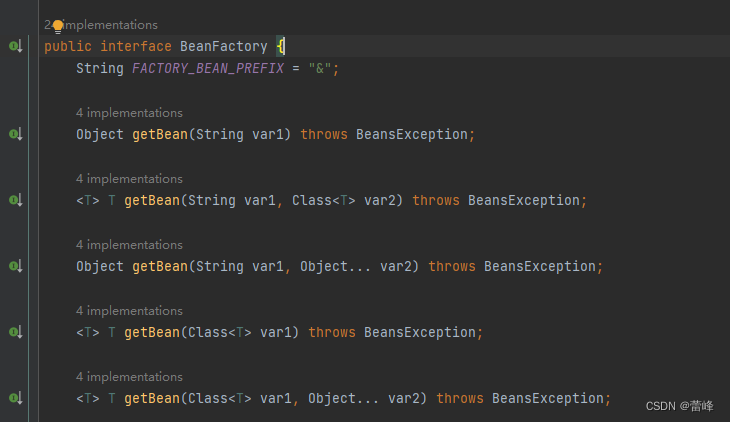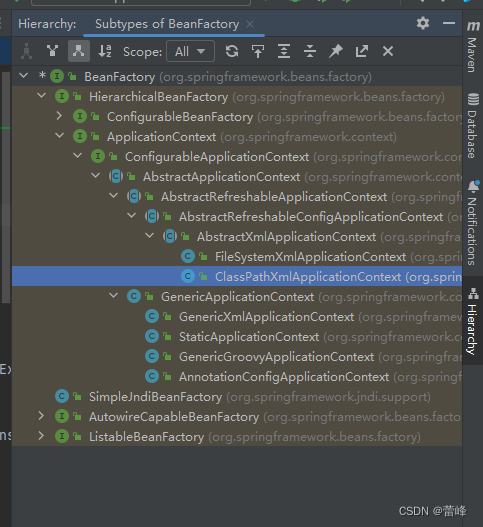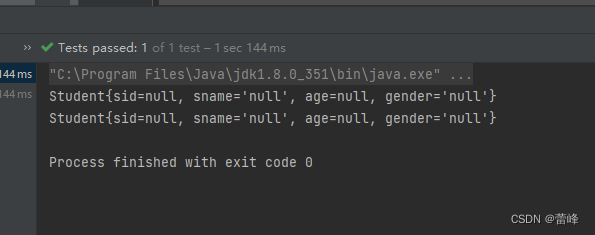官网地址:https://spring.io/
我们进入官网后,点击如下所示。我们会发现许多框架:
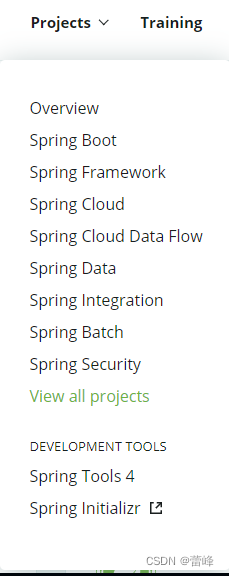
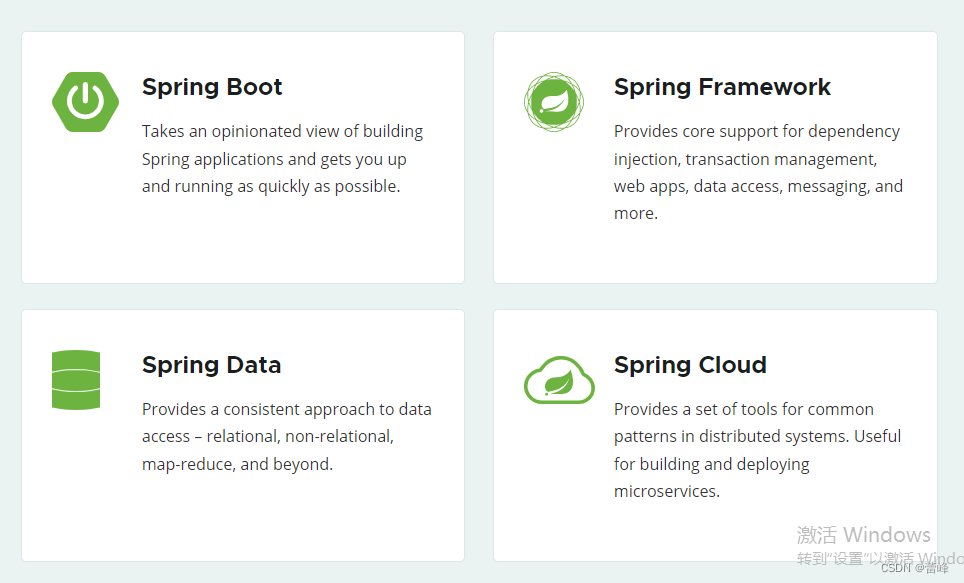
其中,Spring Framework,为spring基础框架, 可以视为Spring基础设施,基本上任何其他Spring项目都是以Spring Framework为基础的。
Spring Framework五大功能模块:
| 功能模块 | 功能介绍 |
| Core Container | 核心容器,在spring环境下使用任何功能都必须基于IOC容器 |
| AOP&Aspects | 面向切面编程 |
| Testing | 提供了对junit或TestNG测试框架的整合 |
| Data Access/Integration | 提供了对数据访问/集成的功能 |
| Spring MVC | 提供了面向Web应用程序的集成功能 |
Spring Framework特性:
非侵入式
控制反转(IOC,翻转资源获取方向,把自己创建资源、向环境索取资源变成环境将资源准备好,我们享受资源注入。)
面向切面编程:AOP:在不修改源代码的基础上增强代码功能。
容器:Spring IOC是一个容器,因为它包含并且管理组建对象的生命周期。
组件化:Spring实现了使用简单的组件配置组合成一个复杂的应用。在Spring中可以使用XML和Java注解组合这些对象,这使得我们可以基于一个个功能明确、边界清晰的组件有条不絮的搭建超大型复杂应用系统。
声明式:很多以前需要编写代码才能实现的功能,现在只需要声明需求即可由框架代为实现
一站式:在IOC和AOP的基础上可以整合各种企业应用的开源框架和优秀的第三方类库。而且Spring旗下的项目已经覆盖了广泛领域,很多方面的功能性需求可以在Spring Framework的基础上全部使用Spring来实现。
IOC容器:
DI:依赖注入
DI是IOC的一种表述方式:即组件以一些预先定义好的方式(例如:setter方法)接受来自容器的资源注入,相对于IOC而言,这种表述更直接。
IOC就是一种反转控制的思想,而DI是对IOC的一种具体实现
IOC容器在Spring中的实现:
Spring提供了IOC容器的两种实现方式:
1、BeanFactory
这是IOC容器的基本实现,是Spring内部使用的接口,面向Spring本身,不提供给开发人员使用。
2.ApplicationContext
BeanFactory的子接口,提供了更多高级特性。面向Spring的使用者,几乎所有场合都使用ApplicationContext而不是底层的BeanFactory。
3.ApplicationContext的主要实现类
我们创建项目spring_helloworld.创建完成之后,我们进行配置依赖如下所示:
<dependencies> <!--基于Maven依赖传递性,导入spring-context依赖即可导入当前所需所有jar包--> <!-- https://mvnrepository.com/artifact/org.springframework/spring-context --> <dependency> <groupId>org.springframework</groupId> <artifactId>spring-context</artifactId> <version>5.3.1</version> </dependency> <!--junit测试--> <dependency> <groupId>junit</groupId> <artifactId>junit</artifactId> <version>4.12</version> <scope>test</scope> </dependency> </dependencies>之后我们双击两次shift键进入搜索界面,我们找到如下所示:
我们点击crtl+h,发现接口的方法如下所示:
我们了解如下所示:
类型名 简介 ClassPathXmlApplicationContext 通过读取类路径下的XML格式的配置文件创建IOC容器对象 FileSystemXmlApplicationContext 通过文件系统路径读取XML格式的配置文件创建IOC容器对象 ConfigurableApplicationContext ApplicationContext的子接口,包含一些扩展方法refresh()和close(),让ApplicationContext具有启动、关闭和刷新上下文的能力。 WebApplicationContext 专门为web应用准备,基于web环境IOC容器对象,并将对象引入存入ServletContext域中
基于XML管理bean:
我们先创建一个类:
package com.rgf.spring.pojo;
public class HelloWorld {
public void sayHello(){
System.out.println("hello,spring");
}
}我们创建一个spring config,spring的配置文件:
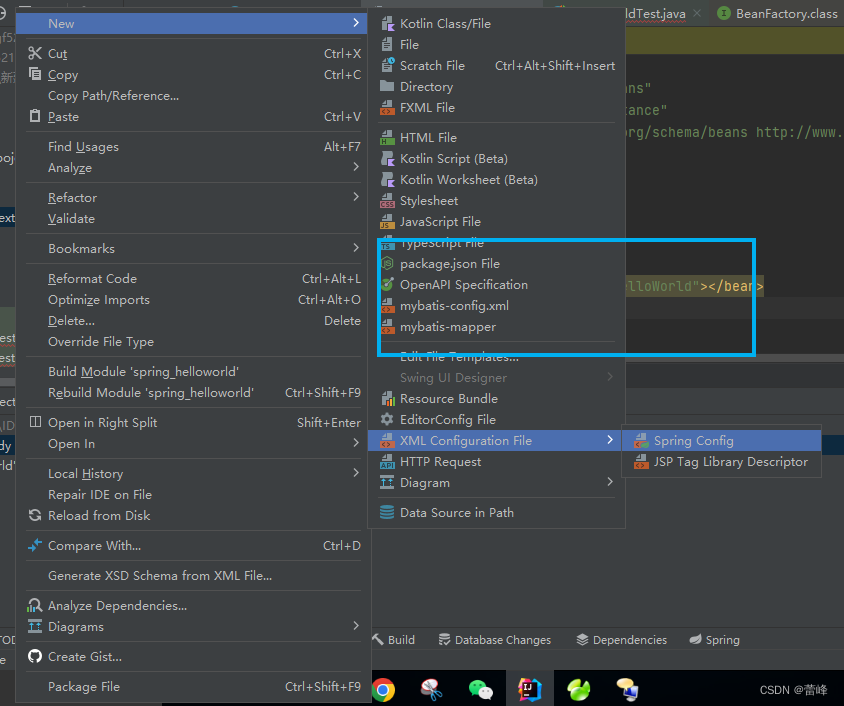
我们的配置文件如下所示:
<?xml version="1.0" encoding="UTF-8"?>
<beans xmlns="http://www.springframework.org/schema/beans"
xmlns:xsi="http://www.w3.org/2001/XMLSchema-instance"
xsi:schemaLocation="http://www.springframework.org/schema/beans http://www.springframework.org/schema/beans/spring-beans.xsd">
<!--
bean:配置一个bean对象,将对象交给IOC容器来管理
属性:
id:bean的唯一标识,不能重复
class:设置bean对象所对应的类型
-->
<bean id="helloworld" class="com.rgf.spring.pojo.HelloWorld"></bean>
</beans> 我们的测试类如下所示:
package com.rgf.spring.test;
import com.rgf.spring.pojo.HelloWorld;
import org.junit.Test;
import org.springframework.context.ApplicationContext;
import org.springframework.context.support.ClassPathXmlApplicationContext;
public class HelloWorldTest {
@Test
public void test() {
//获取ioc容器
ApplicationContext ioc = new ClassPathXmlApplicationContext("applicationContext.xml");
//获取IOC容器中的bean对象
HelloWorld helloworld = (HelloWorld) ioc.getBean("helloworld");
helloworld.sayHello();
}
} 运行之后如下所示:
我们发现出现如上效果,出现如上效果,因为我们把对象交给了IOC容器来管理,我们获取了IOC容器,我们就可以获取IOC容器里面的对象,然后就可以调用容器里面的方法。
IOC容器创建对象的方式:工厂+反射。
我们创建student实体类如下所示: 我们创建学生类交给ioc容器,
package com.rgf.spring.pojo;
public class Student {
private Integer sid;
private String sname;
private Integer age;
private String gender;
public Student() {
}
public Student(Integer sid, String sname, Integer age, String gender) {
this.sid = sid;
this.sname = sname;
this.age = age;
this.gender = gender;
}
public Integer getSid() {
return sid;
}
public void setSid(Integer sid) {
this.sid = sid;
}
public String getSname() {
return sname;
}
public void setSname(String sname) {
this.sname = sname;
}
public Integer getAge() {
return age;
}
public void setAge(Integer age) {
this.age = age;
}
public String getGender() {
return gender;
}
public void setGender(String gender) {
this.gender = gender;
}
@Override
public String toString() {
return "Student{" +
"sid=" + sid +
", sname='" + sname + '\'' +
", age=" + age +
", gender='" + gender + '\'' +
'}';
}
}
我们进行设置spring的核心配置:
<?xml version="1.0" encoding="UTF-8"?>
<beans xmlns="http://www.springframework.org/schema/beans"
xmlns:xsi="http://www.w3.org/2001/XMLSchema-instance"
xsi:schemaLocation="http://www.springframework.org/schema/beans http://www.springframework.org/schema/beans/spring-beans.xsd">
<!--一个bean提供的一个对象,获取这个bean所对应的对象-->
<bean id="studentOne" class="com.rgf.spring.pojo.Student"></bean>
</beans>我们设置的测试类如下所示:
package com.rgf.sping.test;
import com.rgf.spring.pojo.Student;
import org.junit.Test;
import org.springframework.context.ApplicationContext;
import org.springframework.context.support.ClassPathXmlApplicationContext;
public class IOCByXMLTest {
@Test
public void testIOC(){
//获取IOC容器
ApplicationContext ioc = new ClassPathXmlApplicationContext("spring-ioc.xml");
//获取bean
Student studentOne = (Student) ioc.getBean("studentOne");
System.out.println(studentOne);
}
}
因为我们当前只是创建了一个对象,并没有为我们当前对象中的成员变量赋值。
我们运行之后如下所示:
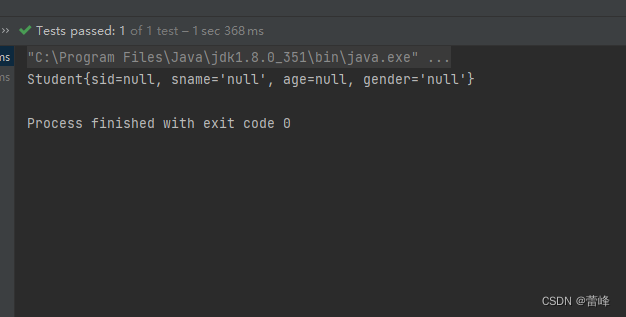
我们将我们的实体类里面的无参构造进行删除之后,我们进行运行:
public Student() {
}我们将其删除,运行之后如下所示: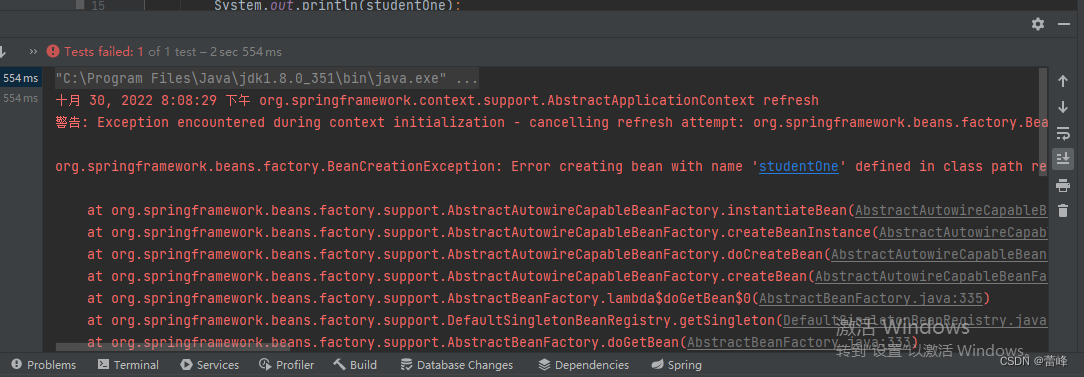
我们发现出现错误。

多个错误的时候我们可以从下往上看,这就是无参构造的错误。
IOC在底层使用的是工厂模式,最基本的实现是BeanFactory,我们之前是使用的是new构造方法。spring是如何帮助我们创建对象的呢:我们获取ioc容器是通过配置文件来获取的,我们是通过当前配置的bean标签来创建对象的,bean标签里面的id为唯一标识。我们在解析这个配置文件的时候,就可以获取咱们bean标签的class属性值。知道了我们当前要管理的对象的类型。由于有多个Bean标签,类型无法确定,我们通过反射来创建某个类型的对象。通过反射来创建一个类型,他的实例化对象的时候,默认使用的就是无参构造。所以我们把无参构造删掉之后,就会出现错误。
获取bean的三种方式:
1.根据bean的id获取:
Student studentOne = (Student) ioc.getBean("studentOne");2.获取bean所需要的类型的class对象:
Student student = ioc.getBean(Student.class);我们运行之后如下所示:
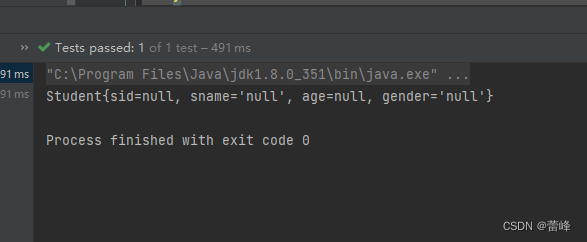
如果我们在bean里面添加如下代码:
<bean id="studentOne" class="com.rgf.spring.pojo.Student"></bean> <bean id="studentTwo" class="com.rgf.spring.pojo.Student"></bean>我们发现运行之后,如下所示:
面对这种情况,我们要确保只有一个,即为单例的。
3.获取bean,获取bean所需要的类型和id
Student student = ioc.getBean("studentOne", Student.class);注意:当根据类型获取Bean时,要求ioc容器中指定类型的bean有且只能有一个
扩展:如果组件类实现了接口,根据接口类型可以获取bean:
我们创建接口Person:
package com.rgf.spring.pojo; public interface Person { }之后我们让该类Student继承该接口:
package com.rgf.spring.pojo; public class Student implements Person{ private Integer sid; private String sname; private Integer age; private String gender; public Student() { } public Student(Integer sid, String sname, Integer age, String gender) { this.sid = sid; this.sname = sname; this.age = age; this.gender = gender; } public Integer getSid() { return sid; } public void setSid(Integer sid) { this.sid = sid; } public String getSname() { return sname; } public void setSname(String sname) { this.sname = sname; } public Integer getAge() { return age; } public void setAge(Integer age) { this.age = age; } public String getGender() { return gender; } public void setGender(String gender) { this.gender = gender; } @Override public String toString() { return "Student{" + "sid=" + sid + ", sname='" + sname + '\'' + ", age=" + age + ", gender='" + gender + '\'' + '}'; } }之后我们进入测试类如下所示:
package com.rgf.sping.test; import com.rgf.spring.pojo.Person; import com.rgf.spring.pojo.Student; import org.junit.Test; import org.springframework.context.ApplicationContext; import org.springframework.context.support.ClassPathXmlApplicationContext; public class IOCByXMLTest { /** * 获取bean的三种方式: * 1.根据bean的id获取 * 2.根据bean的类型获取 * 注意:根据类型获取bean时,要求ioc容器中有且只有一个类型匹配的bean。 * 若没有任何一个类型匹配的bean,此时抛出异常:NoSuchBeanDefinitionException * 若有多个类型类型匹配的bean,此时抛出异常:BeanDefinitionParsingException * 3.根据bean的id和类型获取 * 结论: * 根据类型来获取Bean时,在满足bean唯一性的前提下,其实只是看:|对象 instanceof 指定的类型|的返回的结果, * 只要返回的是true,就可以认定为和类型匹配,能够获取到。 * 即通过bean的类型,bean所继承的类的类型,bean所实现的接口的类型都可以获取bean */ @Test public void testIOC(){ //获取IOC容器 ApplicationContext ioc = new ClassPathXmlApplicationContext("spring-ioc.xml"); //获取bean,获取bean所需要的类型和id // Student student = ioc.getBean("studentOne", Student.class); //System.out.println(student); //我们当前通过Student类型获取了bean之后,把咱们所获取的对象通过向上转型赋值给了他的接口对象 Person student = ioc.getBean(Student.class); System.out.println(student); Person person = ioc.getBean(Person.class); System.out.println(person); } }我们运行之后如下所示:
我们可以通过接口类型来获取bean,但是前提是bean是唯一的。
如果一个接口有多个实现类,这些实现类都配置了bean,根据接口类是不可以获取bean的,因为bean是不唯一的呢
根据类型来获取Bean时,在满足bean唯一性的前提下,其实只是看:对象 instanceof 指定的类型的返回的结果,只要返回的是true,就可以认定为和类型匹配,能够获取到。
